 You can come across them on any walk along the beach, small pieces of torn fishing nets. But they are just the tip of the iceberg. There are probably tens of thousands of tons of ghost nets on the bottom of the Baltic Sea or they got stuck on shipwrecks. These nets not only destroy the sometimes historic wrecks with their weight, but are also a deadly trap for fish, porpoises, seals and birds, which get caught in them and die miserably.
You can come across them on any walk along the beach, small pieces of torn fishing nets. But they are just the tip of the iceberg. There are probably tens of thousands of tons of ghost nets on the bottom of the Baltic Sea or they got stuck on shipwrecks. These nets not only destroy the sometimes historic wrecks with their weight, but are also a deadly trap for fish, porpoises, seals and birds, which get caught in them and die miserably.
The constant water movements mean that small pieces of plastic come off and accumulate in the medium term as microplastics in fish and thus also in us.
The Baltic Sea Heritage Rescue Project (BSHRP) is a project of the German non-profit association Baltic Sea Nature & Heritage Protection Association e.V. (BSNHPA). People from many countries who care about protecting the Baltic Sea above and below the water are volunteering in this project.
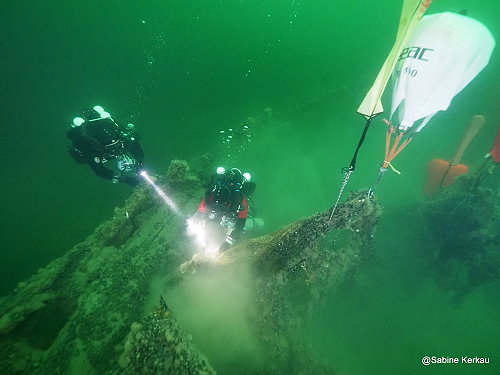 We find and remove lost ghost nets, search, identify and document wrecks to protect them and keep their stories alive. The Baltic Sea Heritage Rescue Project works closely with universities, ministries and archaeologists as well as museums.
We find and remove lost ghost nets, search, identify and document wrecks to protect them and keep their stories alive. The Baltic Sea Heritage Rescue Project works closely with universities, ministries and archaeologists as well as museums.
The diving missions are carried out at depths of up to 100 meters. Only divers trained and experienced for the respective depth are deployed.
Our fight against ghost nets on the deep wrecks of the Baltic Sea began five years ago in Lithuania. At first we just wanted to draw attention to the problem with pictures and videos. However, we quickly realised that this was not enough. Therefore we founded the “Baltic Sea Heritage Rescue Project”. Every year since then we have been organizing six project weeks for hands-on work on wrecks.
One of our goals is to search for, identify and document wrecks that are deeper than 40 meters. In addition to the condition of the wrecks and the artifacts present, this documentation also includes an inventory of the ghost nets that we find on the wreck. We cooperate with the archaeological department of the University of Klaipeda, the Lithuanian Sea Museum, various ministries and the Estonian Heritage Board. We are allowed to salvage the ghost nets from the wrecks under strict controls and with the requirement not to damage the wrecks, some of which are more than a hundred years old.
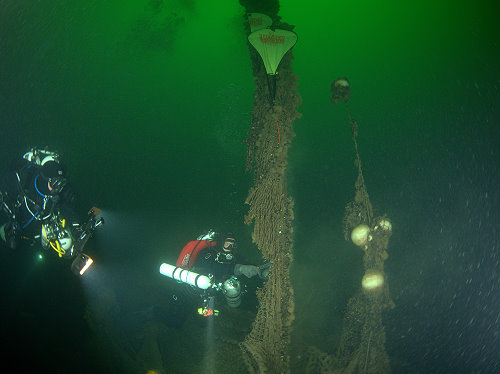 The goal for 2018/19 was to free the wreck of the freighter Elbing IX, which sank in 1914, from ghost nets. The wreck is 80 meters long and lies at a depth of 50 meters. It was wrapped in nets from bow to stern. Some of the nets still had floating bodies, which ensured that they did not lie on the wreck but floated up to 20 meters above it. This is an extremely dangerous situation for all sea creatures and also for us divers. The conditions under which we had to work on the wreck only allowed the use of very experienced divers.
The goal for 2018/19 was to free the wreck of the freighter Elbing IX, which sank in 1914, from ghost nets. The wreck is 80 meters long and lies at a depth of 50 meters. It was wrapped in nets from bow to stern. Some of the nets still had floating bodies, which ensured that they did not lie on the wreck but floated up to 20 meters above it. This is an extremely dangerous situation for all sea creatures and also for us divers. The conditions under which we had to work on the wreck only allowed the use of very experienced divers.
On each dive we document our work on the wreck, locating and checking the nets to be recovered next. A team member takes care of the safety of the divers underwater. The recovery of the nets on the surface must also be documented. Reports for the press and our cooperation partners have to be written and much more.
The successful implementation of our goals is only possible with a strong team and reliable partners. We have to demand the highest quality from both the divers who help us and our equipment. We are particularly grateful to Bauer Compressors for their many years of support. We must be able to rely on a working compressor and clean air to ensure the safety of our dives.
We can only partially influence the circumstances of our work, such as the selection of divers and equipment, but not much else.
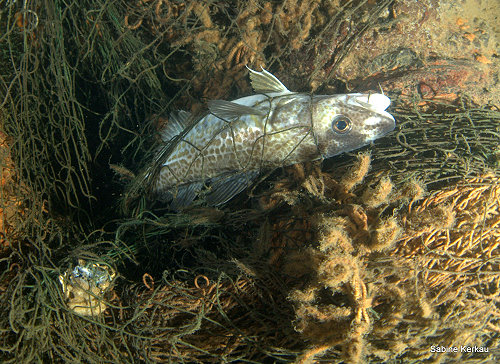 In 2019, for example, we had to cancel two weeks at short notice because the weather didn’t allow for any trips. No one signed up for the third week. In the remaining three weeks we still managed to reach our goal for 2019 to free the Elbing XI from several tons of plastic waste in the form of ghost nets.
In 2019, for example, we had to cancel two weeks at short notice because the weather didn’t allow for any trips. No one signed up for the third week. In the remaining three weeks we still managed to reach our goal for 2019 to free the Elbing XI from several tons of plastic waste in the form of ghost nets.
In the two Corona years 2020 and 2021, the implementation of the project weeks was no easier. Travel restrictions, quarantine rules and much more made planning difficult for us. Nevertheless, in these two years we were able to almost completely clean two wrecks off the Lithuanian coast of lost fishing nets.
Since 2021 we have also been active in the German Baltic Sea off Rügen. In May and October we recovered more than 3.5 tons of nets from the wreck of the Flying Dutchman. The wreck is now completely cleaned. And in 2022 we were able to clean more wrecks off the coast. But there is still a lot to do around Rügen. Our work there continues together with an experienced diving group of Greenpeace and their own boats.
In Lithuania we work on very old wrecks with the permission of the competent authorities and in cooperation with the university and the Lithuanian Sea Museum. At the outset, some of these partners approached us with great skepticism. They saw divers as a greater threat to the wrecks than ghost nets. Divers were equated with looting and destroying. With our work now on-going and many discussions, we are well on the way to changing this opinion. We actively seek to protect the wrecks from looting and destruction.
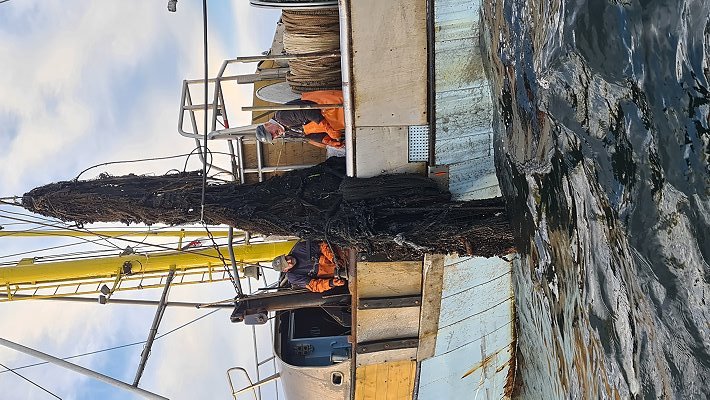 |
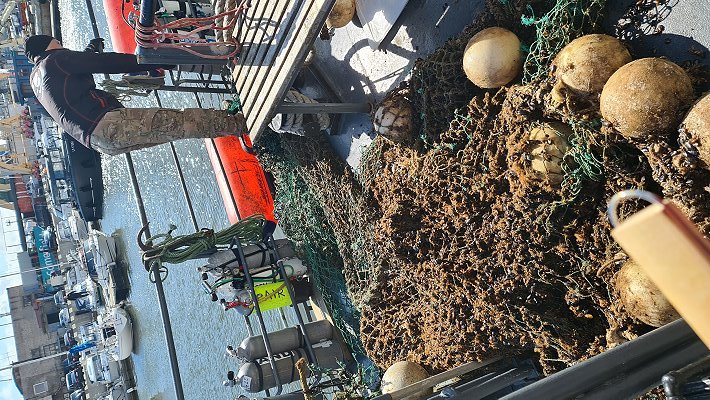 |
| A salvaged net is hoisted on board. | A lot of material has accumulated there. |
 We are often asked: "Why these areas of the Baltic Sea?" The answer is simple. In Lithuania we were for the first time confronted with the problem of ghost nets on this scale. Apparently nobody wanted to do anything about it until then. We encountered similar challenges in Rügen. Sustainability is important to us. This includes reducing plastic waste and preserving cultural heritage. This is only possible if you are persistent and keep talking and informing about the problem. In 2023, we will expand our work even further. Estonia and Sweden are the next destinations.
We are often asked: "Why these areas of the Baltic Sea?" The answer is simple. In Lithuania we were for the first time confronted with the problem of ghost nets on this scale. Apparently nobody wanted to do anything about it until then. We encountered similar challenges in Rügen. Sustainability is important to us. This includes reducing plastic waste and preserving cultural heritage. This is only possible if you are persistent and keep talking and informing about the problem. In 2023, we will expand our work even further. Estonia and Sweden are the next destinations.
The Baltic Sea Nature and Heritage Protection Association e.V. provides some of the financial support for the projects, in particular for ship charters, special tools and the transport of the nets to the processing companies. We finance most of our work out of our own pockets. Anyone who would like to help us can do so by becoming a member of the Baltic Sea Nature & Heritage Protection Association e.V. or by making a donation to the association. We also need divers of all levels of training and non-divers who actively support us during the project weeks.
More infos at: www.bsnhpa.org or per mail to This email address is being protected from spambots. You need JavaScript enabled to view it.
The author, Sabine Kerkau, is the chairwoman of the Baltic Sea Nature & Heritage Protection Association e.V. and kindly provided us with this article with photos for our website.








